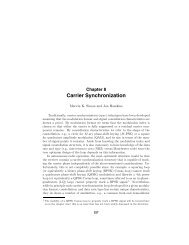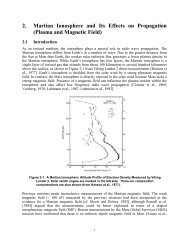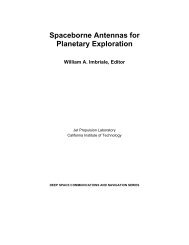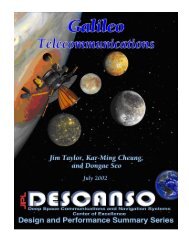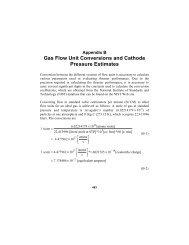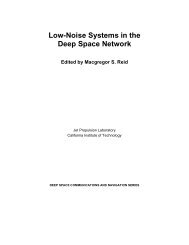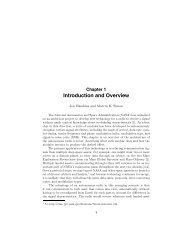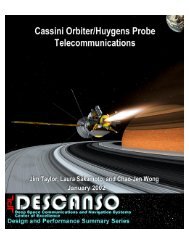Propagation Effects Handbook for Satellite Systems - DESCANSO ...
Propagation Effects Handbook for Satellite Systems - DESCANSO ...
Propagation Effects Handbook for Satellite Systems - DESCANSO ...
Create successful ePaper yourself
Turn your PDF publications into a flip-book with our unique Google optimized e-Paper software.
where Tm is the ambient temperature, Y is the absorption<br />
coefficient, and 7 is the optical depth to the point under<br />
consideration. In radio engineering terms ‘<br />
7 = 4.343 A dB (6.8-4)<br />
where A is the absorption over the path in question, in dB. For<br />
frequencies above 10 GHz, the second term on the righthand side of<br />
Eq. (6.8-3) reduces to 2.7 K, the cosmic background component,<br />
unless the Sun is in the antenna beam, as illustrated in Figure<br />
6.8-1.<br />
For an isothermal atmosphere (Tm constant with height),<br />
substituting Ydl = dT in Eq. (6.8-3) yields<br />
T~=Tm(l-e’)=Tm [ 1-10-* 1 K (6.8-5)<br />
where A is again atmospheric absorption in dB. The value of T m<br />
taken in Eq. (6.8-4) ranges from 260 to 280 K. One relationship<br />
used to determine a value of T m from surface measured temperature<br />
is (Wulfsberg-1964)<br />
T m = 1.12 Ts - 50 K (6.8-6)<br />
where Ts is the surface temperature in K.<br />
Noise temperature (or brightness temperature) curves <strong>for</strong> 3, 7.5,<br />
and 17 g/m3 surface water vapor content, with the US Standard<br />
Atmosphere <strong>for</strong> the two lower values and the Tropical Atmosphere <strong>for</strong><br />
the highest value, have been published by Smith (1982) and<br />
reproduced in CCIR Report 720-2 (CCIR-1986h). Examples <strong>for</strong> an<br />
average humidity state (7.5 g/m 3<br />
at the surface) are reproduced as<br />
Figures 6-8-2 and 6.8-3.<br />
6-132<br />
-





